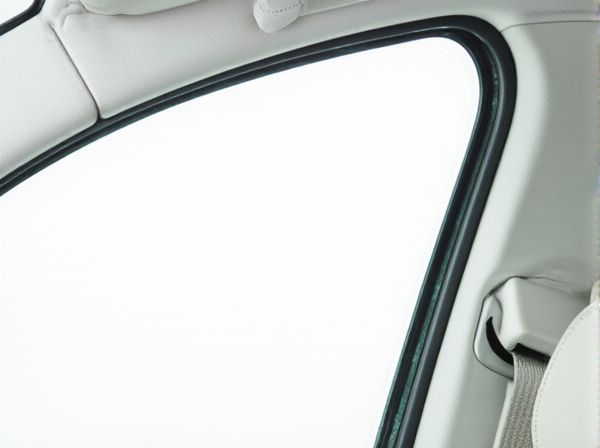
Photo illustration: Acoustic Glass Window vs Standard Glass Window
Acoustic glass windows significantly reduce noise pollution by incorporating laminated layers that absorb sound waves, enhancing your living or working environment's tranquility. Standard glass windows offer basic light transmission and insulation but lack the specialized construction needed for effective soundproofing. Choosing acoustic glass ensures better noise control, improving comfort without compromising natural light.
Table of Comparison
| Feature | Acoustic Glass Window | Standard Glass Window |
|---|---|---|
| Noise Reduction | High noise insulation, reduces external sound significantly | Minimal noise insulation, allows more external sound |
| Material Composition | Laminated glass with sound-damping interlayer | Tempered or laminated standard glass without special layers |
| Safety | Enhanced safety due to laminated layers | Standard safety features |
| Weight | Slightly heavier due to added layers | Lighter, standard thickness |
| Cost | Higher price due to advanced materials and benefits | Lower price, widely available |
| Heat Insulation | Moderate heat insulation | Basic heat insulation |
| Durability | More durable, resistant to cracks and impacts | Standard durability |
Introduction to Acoustic Glass and Standard Glass Windows
Acoustic glass windows consist of laminated glass layers designed to reduce noise transmission by dampening sound waves, making them ideal for urban environments and high-traffic areas. Standard glass windows typically use single or double-pane glass without specialized soundproofing features, resulting in less effective noise insulation. Acoustic glass improves indoor comfort by significantly minimizing external noise, whereas standard glass primarily serves basic protection and insulation purposes.
What is Acoustic Glass?
Acoustic glass is a specialized type of laminated glass designed to reduce noise pollution by incorporating an inner layer of sound-dampening interlayer, typically made from polyvinyl butyral (PVB) or ethylene-vinyl acetate (EVA). This construction significantly enhances sound insulation compared to standard glass windows, which are usually single-pane or double-glazed without soundproofing properties. Acoustic glass windows provide superior noise reduction for urban environments, improving indoor comfort by minimizing external sound transmission.
Standard Glass Windows: An Overview
Standard glass windows typically consist of a single pane of clear or tinted glass, offering basic visibility and light transmission but limited sound insulation. These windows are commonly made from annealed or tempered glass, providing standard thermal performance and safety features without specialized noise reduction properties. While cost-effective and widely available, standard glass windows do not effectively block external noise, making them less suitable for environments requiring enhanced acoustic privacy.
Key Differences Between Acoustic and Standard Glass Windows
Acoustic glass windows feature laminated glass layers combined with sound-damping interlayers, significantly reducing external noise compared to standard single-pane or double-pane glass windows. They provide enhanced sound insulation performance measured in STC (Sound Transmission Class) ratings, often achieving values above 35, while standard glass windows typically range between 18 and 27. Acoustic glass also offers improved thermal insulation and vibration dampening, making it ideal for urban environments and noisy areas.
Sound Insulation: Which Window Performs Better?
Acoustic glass windows outperform standard glass windows in sound insulation due to their specialized laminated design, which incorporates multiple glass layers bonded with sound-damping interlayers. These windows significantly reduce external noise by absorbing and blocking sound waves, achieving Noise Reduction Coefficients (NRC) up to 0.9, compared to standard single-pane windows that typically have NRC values around 0.3. This superior performance makes acoustic glass windows ideal for urban environments, busy streets, and locations requiring enhanced noise control.
Energy Efficiency Comparison
Acoustic glass windows feature laminated layers with specialized interlayers that provide superior thermal insulation compared to standard glass windows, significantly reducing heat transfer and energy consumption for heating and cooling. The enhanced airtight seal and soundproofing qualities of acoustic glass contribute to maintaining consistent indoor temperatures, resulting in lower energy bills and improved HVAC system efficiency. Standard glass windows generally lack these multiple insulating layers, leading to higher heat loss in winter and heat gain in summer, which decreases overall energy efficiency.
Installation Process and Compatibility
Acoustic glass windows require precise installation techniques, including the use of specialized seals and spacers to maximize soundproofing efficiency, which often extends installation time compared to standard glass windows. Compatibility with existing frames depends on the thickness and weight differences; acoustic glass typically demands reinforced or custom frames to support its heavier structure. Standard glass windows offer more straightforward installation and broader compatibility with conventional framing materials, making them a quicker option for typical residential applications.
Cost Analysis: Acoustic Glass vs Standard Glass
Acoustic glass windows typically cost 20-50% more than standard glass windows due to their specialized laminated or double-glazed construction designed for superior sound insulation. Installation expenses may also be higher for acoustic glass because of the increased weight and complexity compared to single-pane or basic double-pane standard windows. Despite the upfront cost difference, acoustic glass windows offer long-term value through enhanced noise reduction and potential energy savings, which standard glass windows lack.
Maintenance and Longevity
Acoustic glass windows feature laminated layers that enhance durability and reduce maintenance compared to standard glass, which is more prone to scratches and breakage. The specialized construction of acoustic glass also resists weathering and UV damage, extending its lifespan significantly beyond that of conventional windows. Regular cleaning with non-abrasive materials preserves both types, but acoustic glass's robust design results in lower long-term repair and replacement costs.
Choosing the Right Window for Your Needs
Acoustic glass windows provide superior sound insulation compared to standard glass, making them ideal for homes near busy roads or noisy environments. These windows utilize laminated or double-glazed panes with a sound-dampening layer that reduces external noise by up to 50%, enhancing indoor comfort. Standard glass windows offer budget-friendly options but lack the advanced noise reduction properties essential for creating quiet living spaces.
 caratoz.com
caratoz.com